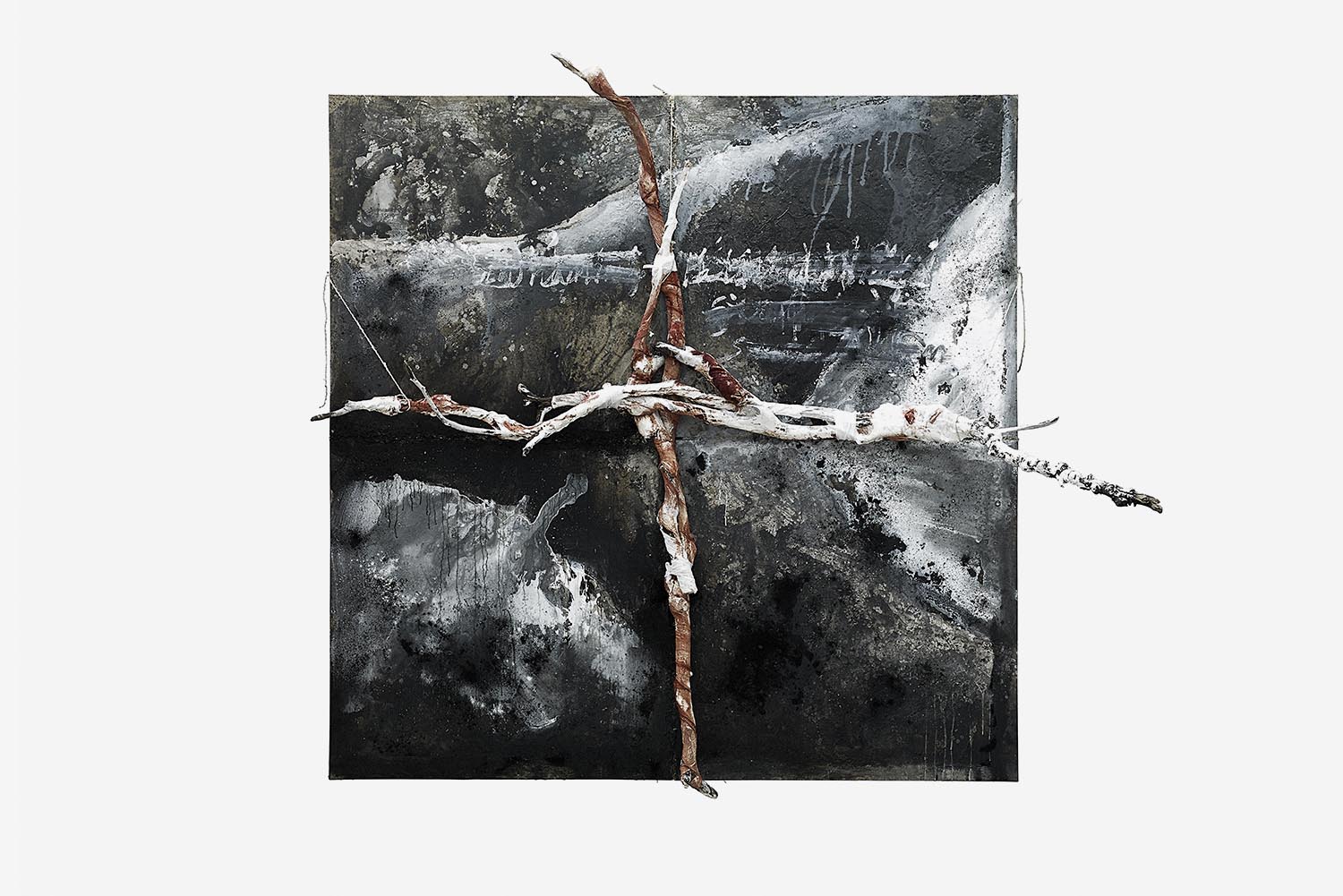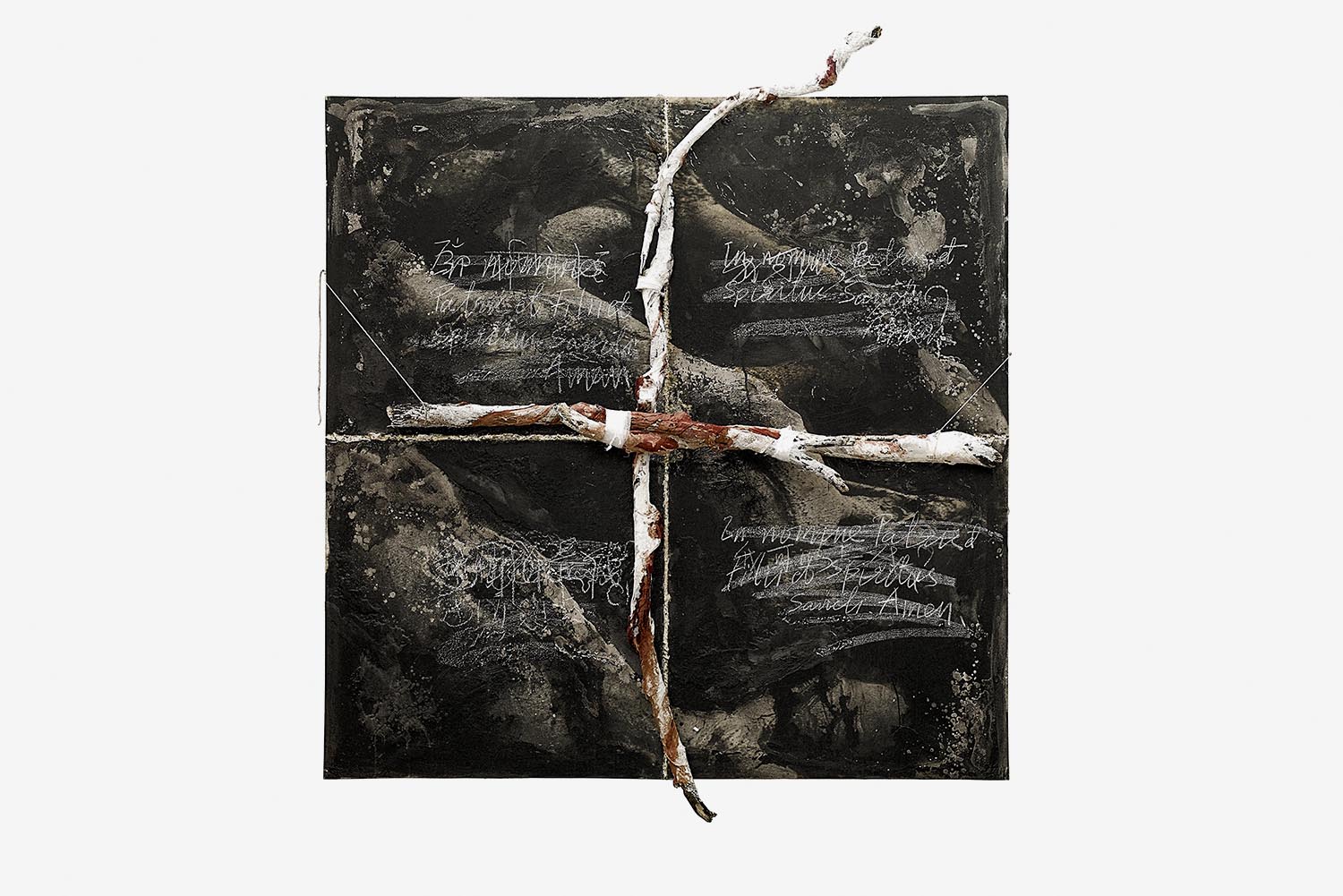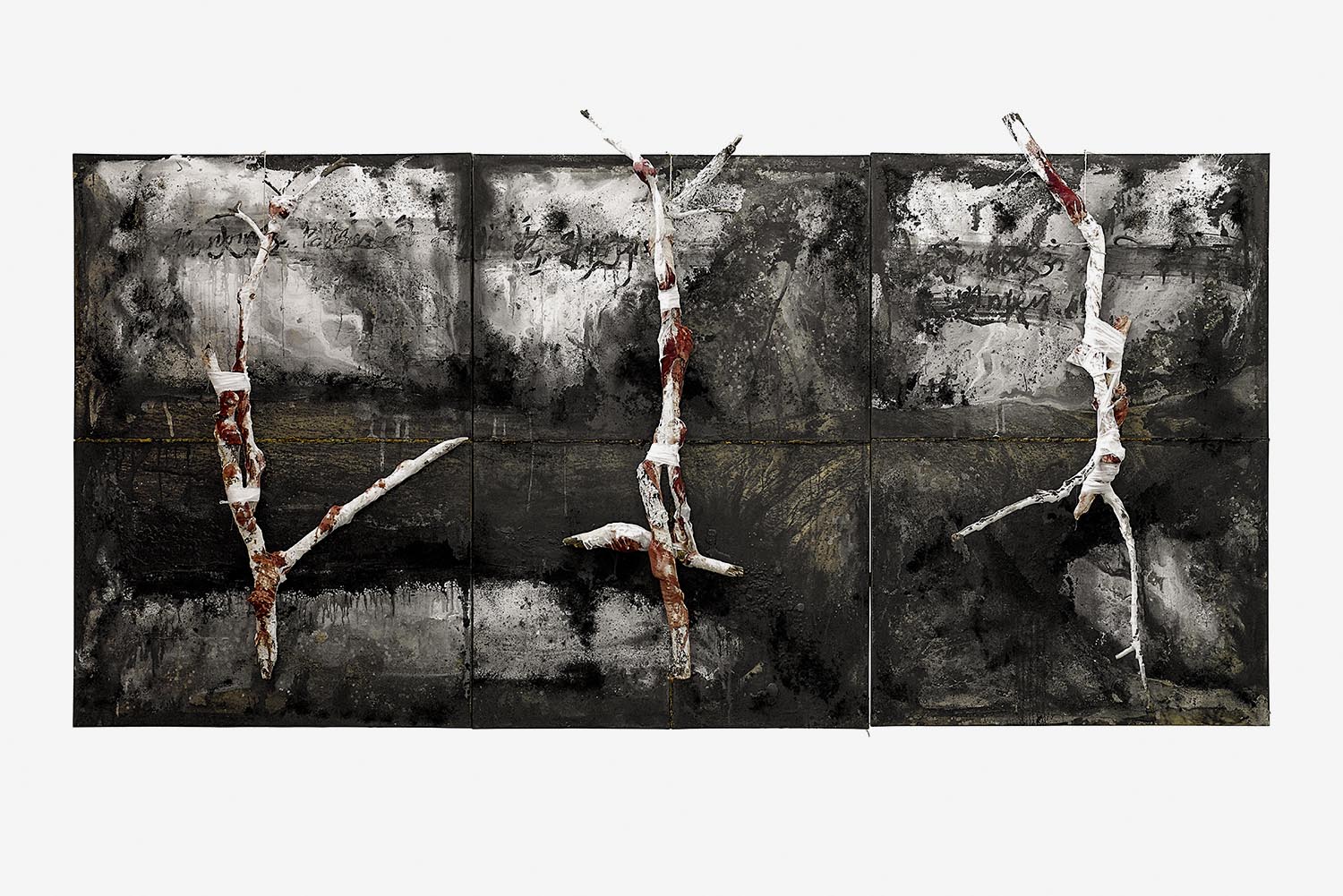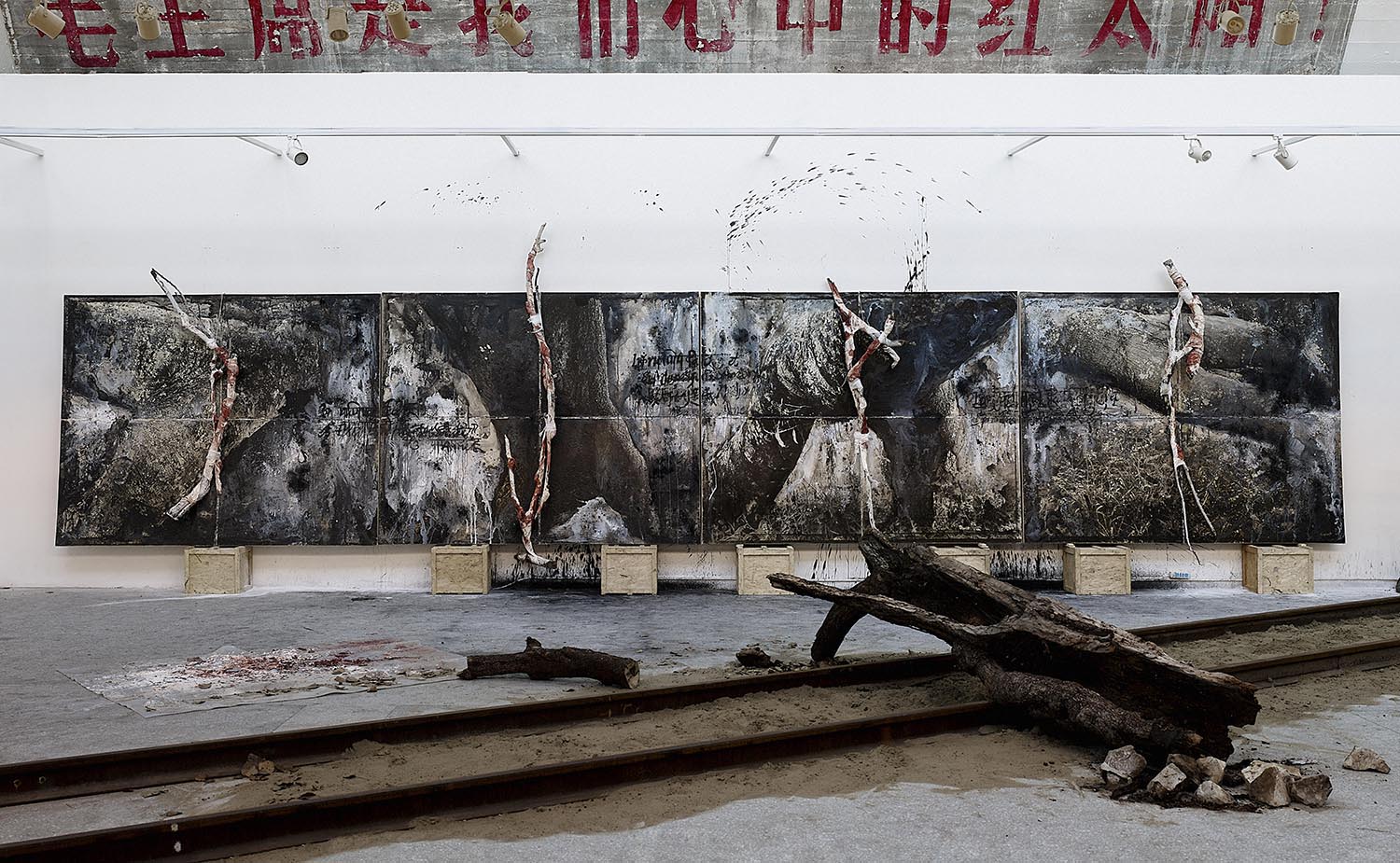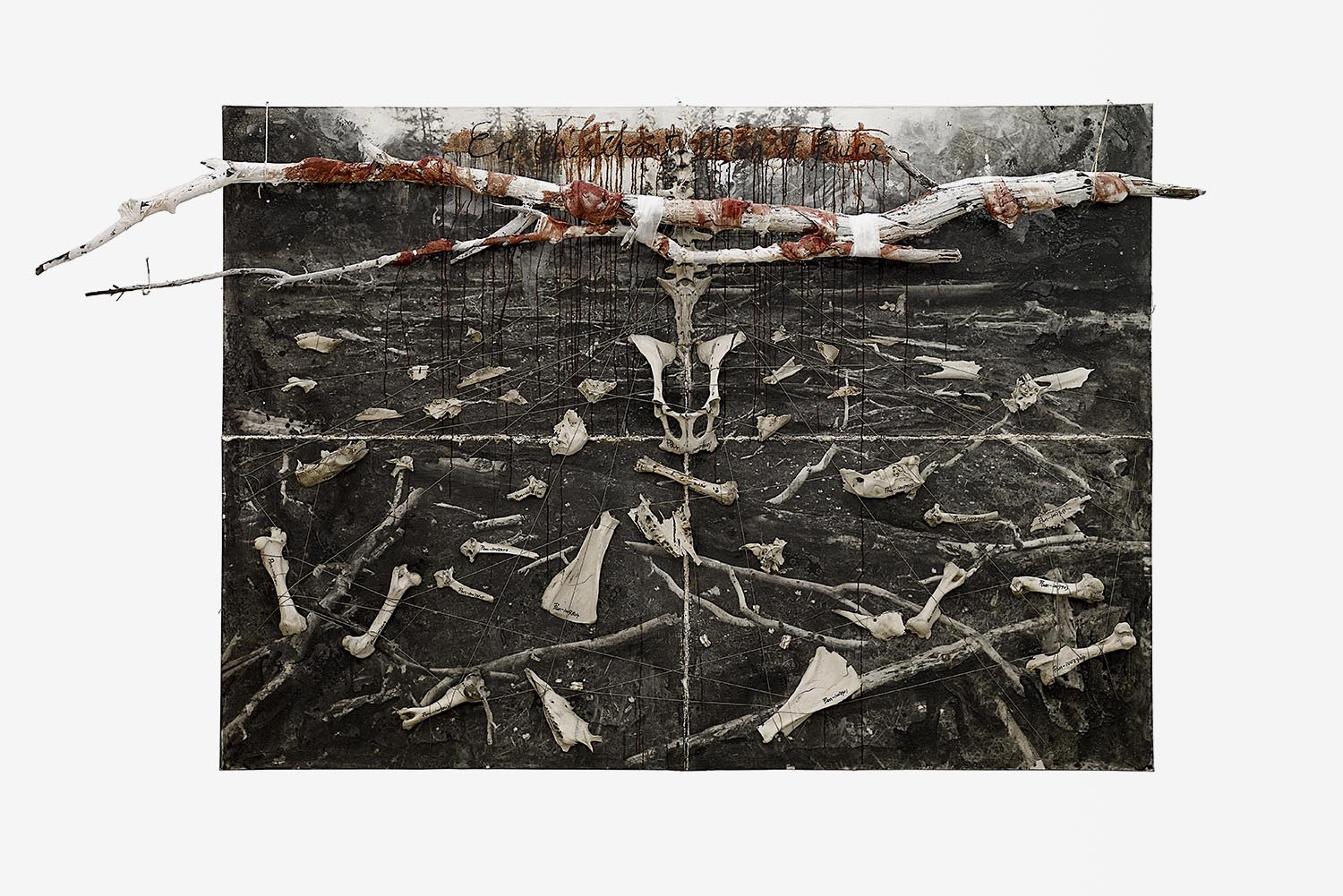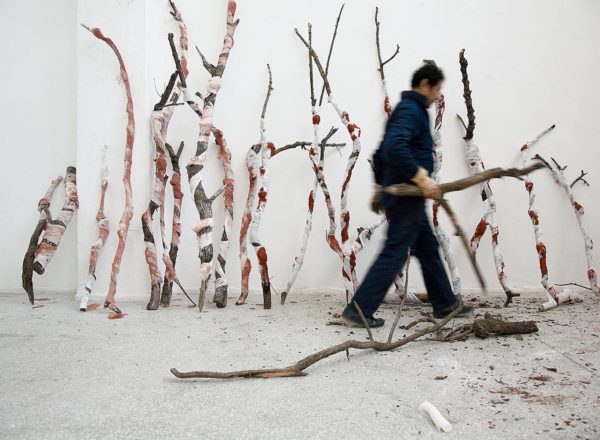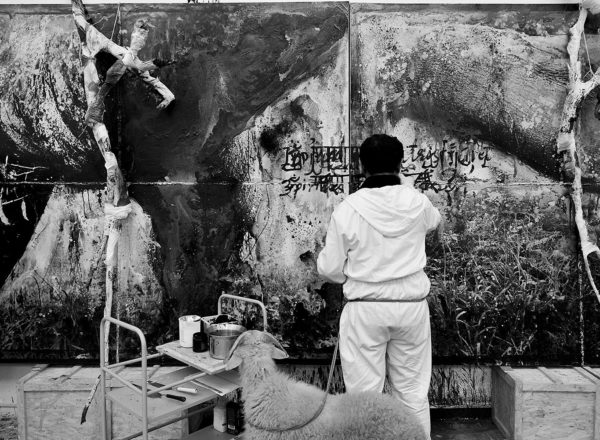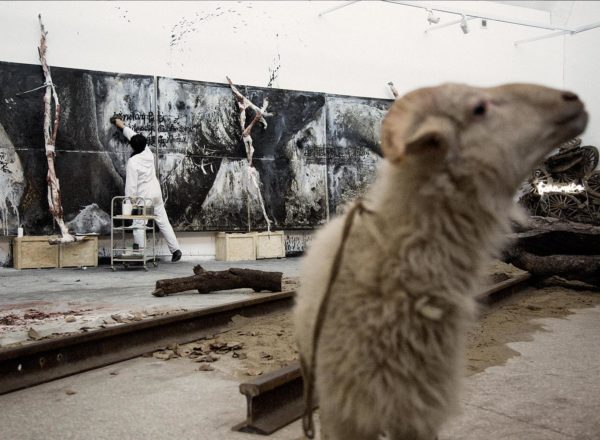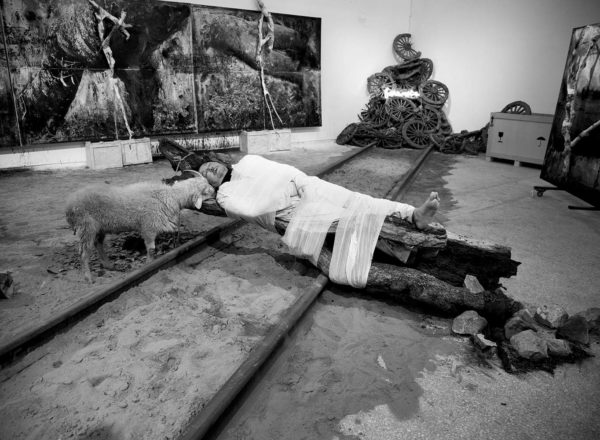Requiem-I
Photography and mixed media, 220 x 220 cm, village of Shangyuan, Beijing, 2011-2015.
Photography, silver bromide emulsion print, painted and written on by hand in ink, charcoal, fusain, emulsion paint, wood ash and acrylic, branch wrapped in medical bandage and blood painted on canvas.
Requiem-II
Photography and mixed media, 220 x 220 cm, village of Shangyuan, Beijing, 2011-2015.
Photography, silver bromide emulsion print, painted and written on by hand in ink, charcoal, fusain, emulsion paint, wood ash and acrylic, branch wrapped in medical bandage and blood painted on canvas.
The suite of works that comprise Requiem has 8 pieces which share the same composition, motifs and media: Each of the large size rectangular compositions has a photograph of the limbs of a tree treated in the same manner as the Rejected Quatrain, with washes of silver emulsion covering the surface with abstract expressionistic patterns, but other materials are added: charcoal, and chalk, and limbs of desiccated trees wrapped in white linen bandages that are smeared with pigs’ blood. This series of oversized canvases are organized like a musical symphony with themes and variations and interludes. They repeat, develop, refer back to each other and reach a triumphant climax that takes place in real time.
Requiem I and II
For this part of the project, intended as a requiem for his mother, GB invited religious representatives of Christianity, Buddhism and Islam to participate, but only the Buddhists agreed to participate. So GB inscribed on the surface of the works passages of Sanskrit, Arabic and Latin. As these prayers are his fabrication, they are invalid; they are not sacred offerings but meaningless script that alludes to the original, but only by approximation. Once again, being illegible, he had to obscure them. By this act of writing prayers in various languages from the three principal world religions, GB says he wanted to invoke the harmony of the human race. But reaching a harmonious accord is impossible in this world since terrible things keep happening that disrupt peace. Even the simple effort of organizing the participation of religious clerics was hard to realize. He asks, “How can then can this world have a common understanding?” So he wiped out the pseudo religious passages and wrote in Chinese characters “Can I become (the messenger) myself?” Dominating each of the compositions is a dried tree branch affixed to the surface by means of medical bandages. GB contemplated this project for many years, preparing the materials initially without any specific plan. The tree branches come from felled trees in his garden, which he collected and dried out, a process that lasted two years. Placed on top of the photograph of trees, the branches transform the two-dimensional image into a three-dimensional object. These branches exceed the boundaries of the painting, projecting beyond its limits. Emerging from the background, the dead limbs takes on life, bleeding and bandaged. Arranged like a cross, the two branches are redolent of suffering, of sacrifice.
Layers and layers of imagery comprise these works, over the photograph of the tree the artist created an abstract composition. As in Quatrain Denied, splashes of emulsion create abstract patterns of dark and light forms. Each nuance of the application of the wash takes on a narrative content, emerging, surging, negated, highlighted and blackened out. Writing in white chalk poses unanswerable questions that culminate in the three-dimensional forms of the dead limbs. The white calligraphy looks like writing on a chalkboard, tentative, inconclusive and evolving. The dynamic interactions of these pictorial elements are mesmerizing. GB explains in this way he invokes both the invisible and visible, both balanced against the other; both of equal importance; both expressing the inexpressible.
– Dr. Patricia Eichenbaum Karetzky
Requiem – III / The immensity of Death
Photography and mixed media, triptych, 200 x 420 cm, village of Shangyuan, Beijing, 2011- 2015.
Photography, silver bromide emulsion print, painted and written on by hand in ink, charcoal, fusain, emulsion paint, wood ash and acrylic, branch wrapped in medical bandage, blood painted on canvas.
Requiem III The Immensity of Death is a triptych, each part having two equal rectangles. Appearing similar to Requiem I and II, these works differ in that the branch secured to the surface of each quadrangle forms a single vertical element. Each one stands against an abstract composition of emulsion, Chinese ink, charcoal, and ashes. The anthropomorphic shape, with limbs askew, is bandaged and bleeding. Now the background composition resembles the pictorial organizations of Rothko: large rectangles of light and dark, luminescent and transparent at times, with edges eroded by the action of the dripping ink and large swathes of silver emulsion. But unlike Rothko, the narrative is more insistent: the natural withered forms allude to the skeletons of crucified victims. Despite the macabre imagery, the canvases are sumptuous, rich with subtle monochromatic compositions. Examining the details of the applications of black and white elements invokes the delicate and vigorous passages of Chinese monochrome scholarly landscape painting: the ink is freely applied; oblivious of the object being described and emphatic in its kinetic power.
– Dr. Patricia Eichenbaum Karetzky
Requiem-IV / The immensity of Death
Photography and mixed media, quadriptych, 220 x 1120 cm, village of Shangyuan, Beijing, 2011- 2015.
Photography, silver bromide emulsion print, painted and written on by hand in la main avec de ink, charcoal, fusain, emulsion paint, wood ash and acrylic, branch wrapped in medical bandage, blood painted on canvas.
Requiem IV, The Immensity Of Death, a variation of the structure of the statement and restatement of the motifs and materials, is another ode to the cruelty of life. Now in a quartet of canvases, the landscape looms summoning the immensity of nature and its transient forms. These works, arranged in the middle of the exhibition space, are freed from the walls. The intended installation places them at intervals alongside a set of rail- road tracks laid over fresh earth. Sections of huge dead tree trunks lay across the tracks. At one end of the tracks is a pile of broken wagon wheels with a neon Sanskrit word famarita. The use of these found objects injects many references to the past, to times when wagon wheels represented a mode of transportation; the railroad tracks too evoke the lost industrial era. In a performance, GB lies on the railroad tracks, a message of hopeless self-sacrifice. One errant detail inflects the whole experience with hope, the hope of art to transcend, to interpret, to be a balm to suffering. A sheep, bought to feed the religious clerics who never participated, was saved from slaughter to roam the exhibition hall. Affectionately, he licks the face of the sacrificial victim. Like the end of the Japanese post war movie Roshomon one act of kindness redeems the human race.
For followers of Laostism, being lost is the perpetual act of discovery.
– Dr. Patricia Eichenbaum Karetzky
Requiem-V / Looking For Pan And Faun
Photography and mixed media, 220 x 280 cm, village of Shangyuan, Beijing, 2011-2015.
Photograph, gelatin silver bromide emulsion print, paint and writing in blood, Chinese ink, charcoal and pastel, wood ash, hemp rope, metal cable, medical bandage, animal bones found in Tibet on canvas.
Requiem V Finding Pan and Faun was begun in 2010 and reworked for this installation. The photo, relatively unobscured, appears like a document of an archaeological dig. In the deeply perspectival view, a grove of autumnal trees is visible in the distance.Replacing the old dead tree of the other paintings are animal bones laid out in a grid formation suggesting an ancient primitive peoples’ ritual sacrifice. The bones, as though studied by scientists, are labeled. Rope divides the photograph into quadrants. Affixed to the surface of the upper part is a large withered branch, wrapped in bandages and splattered with blood. Also splashed in blood is an elegiac title written in French at the top, Searching for Pan and Faun. These scientific finds are desecrated by a blood sacrifice. GB explains the title refers respectively to the ancient Greek and Roman gods of nature, the faun in particular alludes to Debussy’s Prelude to the Afternoon of a Faun a pastoral sexualized romance. He explains both are seducers of men, protectors of nature, and indicators of a golden age when man lived in harmony with nature.
– Dr. Patricia Eichenbaum Karetzky
